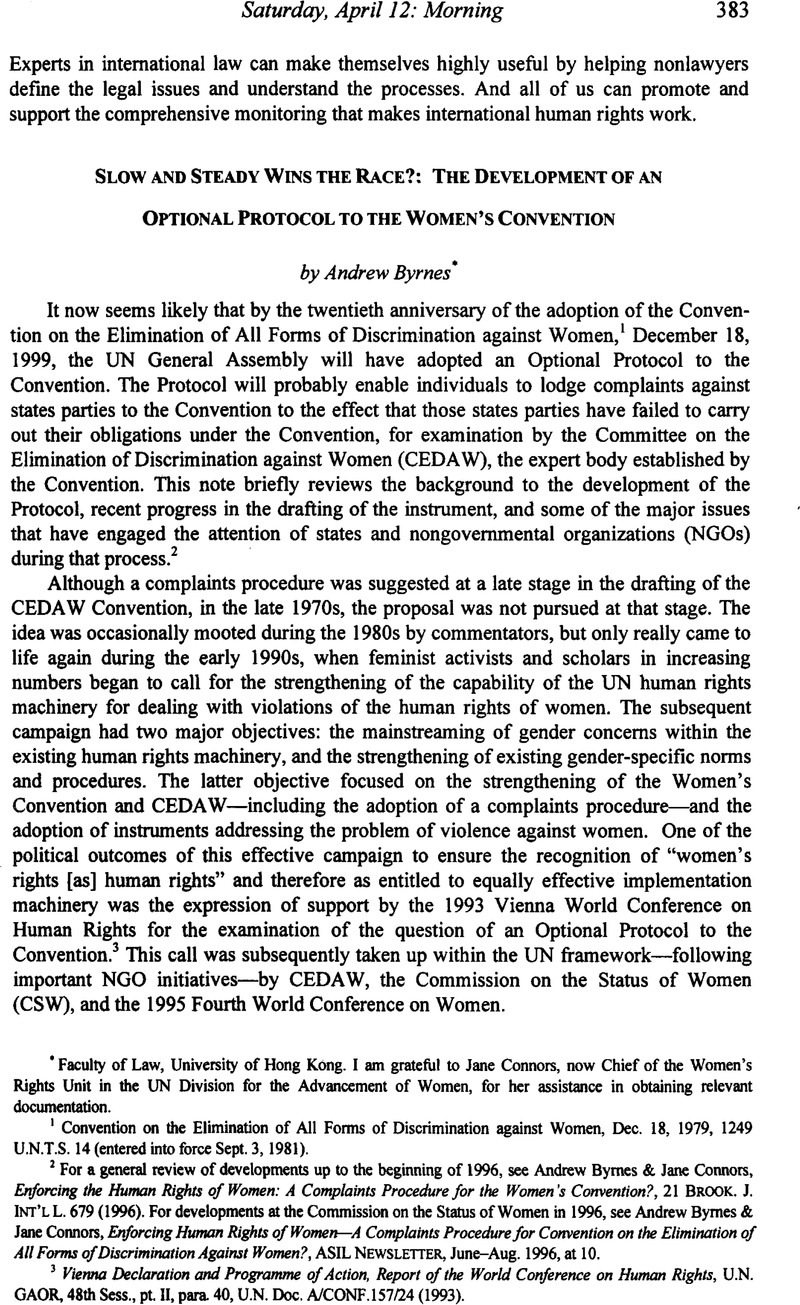Article contents
Slow and Steady Wins the Race?: The Development of an Optional Protocol to the Women’s Convention
Published online by Cambridge University Press: 28 February 2017
Abstract

- Type
- Compliance with the International Human Rights of Women
- Information
- Copyright
- Copyright © American Society of International Law 1997
References
1 Convention on the Elimination of All Forms of Discrimination against Women, Dec. 18, 1979, 1249 U.N.T.S. 14 (entered into force Sept. 3, 1981).
2 For a general review of developments up to the beginning of 1996, see Byrnes, Andrew & Connors, Jane, Enforcing the Human Rights of Women: A Complaints Procedure for the Women‘s Convention?, 21 Brook. J. Int’l L. 679 (1996)Google Scholar. For developments at the Commission on the Status of Women in 1996, see Byrnes, Andrew & Connors, Jane, Enforcing Human Rights of Women—A Complaints Procedure for Convention on the Elimination of All Forms of Discrimination Against Women?, ASIL Newsletter, June-Aug. 1996, at 10Google Scholar.
3 Vienna Declaration and Programme of Action, Report of the World Conference on Human Rights, U.N. GAOR, 48th Sess., pt. II, para. 40, U.N. Doc. A/CONF.157/24 (1993).
4 The driving force was the then-Director of the Women in the Law Project of the Law Group, Donna Sullivan. Also critical to the organization and success of the initiative was the role played by the Professors Cees Flinterman and Theo van Boven of the Faculty of Law of the University of Maastricht, which hosted the seminar, which was generously underwritten by the Netherlands and Australian Governments and the European Human Rights Foundation.
5 For the text of the Maastricht draft, see Byrnes & Connors, Enforcing the Human Rights of Women, supra note 2, at 784-97; Draft Optional Protocol to the Convention on the Elimination of All Forms of Discrimination against Women, 44 AM. U. L. Rev. at 1419 (1995); Flinterman, Cees, Draft Optional Protocol to the Convention on the Elimination of All Forms of Discrimination against Women, 13 Neth. Q. Hum. Rts 85, 86 (1995)CrossRefGoogle Scholar. For a detailed discussion of the contents of the Maastricht draft, see Byrnes & Connors, Enforcing the Human Rights of Women, supra note 1.
6 Suggestion No. 7, Elements for an Optional Protocol to the Convention on the Elimination of All Forms of Discrimination against Women, U. N. Report of the Committee on the Elimination of Discrimination against Women, U.N. GAOR, 14th Sess., Supp No. 38, at 8, U.N. Doc. A/50/38 (1995).
7 See Report of the Open-Ended Working Group on the Elaboration of a Draft Optional Protocol to the Convention on the Elimination of All Forms of Discrimination against Women, Commission on the Status of Women (Mar. 11-22, 1996), U.N. ESCOR, 40th Sess., Supp. No. 6, Annex 111, U.N. Doc. E/1996/26 (1996).
8 For a summary of the additional views, see Additional Views of Governments, Inter-govemmental Organizations and Non-governmental Organizations on an Optional Protocol to the Convention, Commission on the Status of Women, 41st Sess., U.N. Doc. E/CN.6/1997/5 (Feb. 18, 1997).
9 Working Group on the Elaboration of a Draft OP to the Convention on Women, Note by the Secretariat, Commission on the Status of Women, 41st Sess., Annex, U.N. Doc. E/CN.6/1997/WG/L.1 (1997). A member of CEDAW, Justice Silvia Cartwright of New Zealand, attended the working group’s meetings as a resource person.
10 Revised Draft Optional Protocol, Commission on the Status of Women, U.N. ESCOR, 41st Sess., Supp. No. 7, Annex III, app. I, U.N. Doc. E/1997/27 (1997).
11 For a review of the discussions, see Report of the Open-Ended Working Group on the Elaboration of a Draft Optional Protocol to the Convention on the Elimination of All Forms of Discrimination against Women, Commission on the Status of Women, U.N. ESCOR, 41st Sess., Supp. No. 7, Annex III, U.N. Doe. E/1997/27 (1997).
12 Optional Protocol to the International Covenant on Civil and Political Rights, Dec. 16, 1966, 999 U.N.T.S. 171, 301.
13 International Covenant on Civil and Political Rights, Dec. 16, 1966, 999 U.N.T.S. 171.
14 International Convention on the Elimination of All Forms of Racial Discrimination, Mar. 7, 1966, 660 U.N.T.S. 195 (entered into force Jan. 4, 1969).
15 Convention against Torture and Other Forms of Cruel, Inhuman or Degrading Treatment or Punishment, Dec. 10, 1984, 23 I.L.M. 1027.
16 At the 1997 session of the Commission on the Status of Women, China, Iran and Cuba were die most active of those states committed to limiting the scope and effectiveness of any Protocol.
17 Revised Draft Optional Protocol, supra note 10, at 2-3, art. 2.
18 Discussion continues over whether five, ten or even twenty ratifications are appropriate for entry into force of the protocol.
- 1
- Cited by


